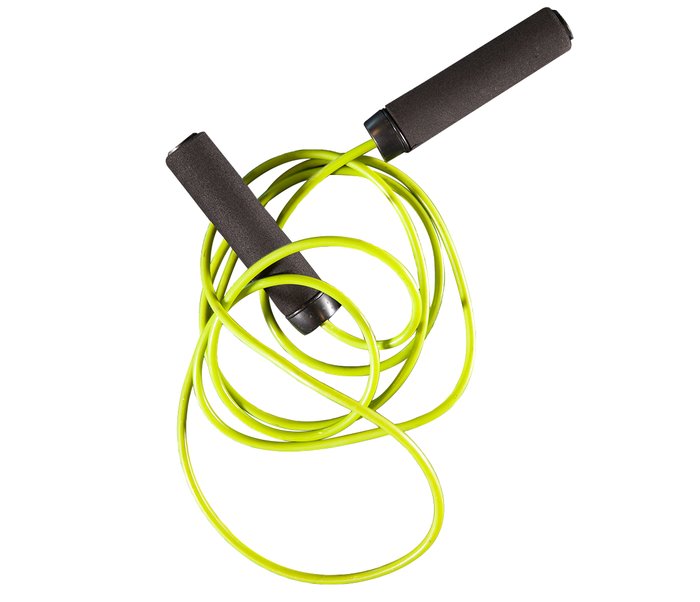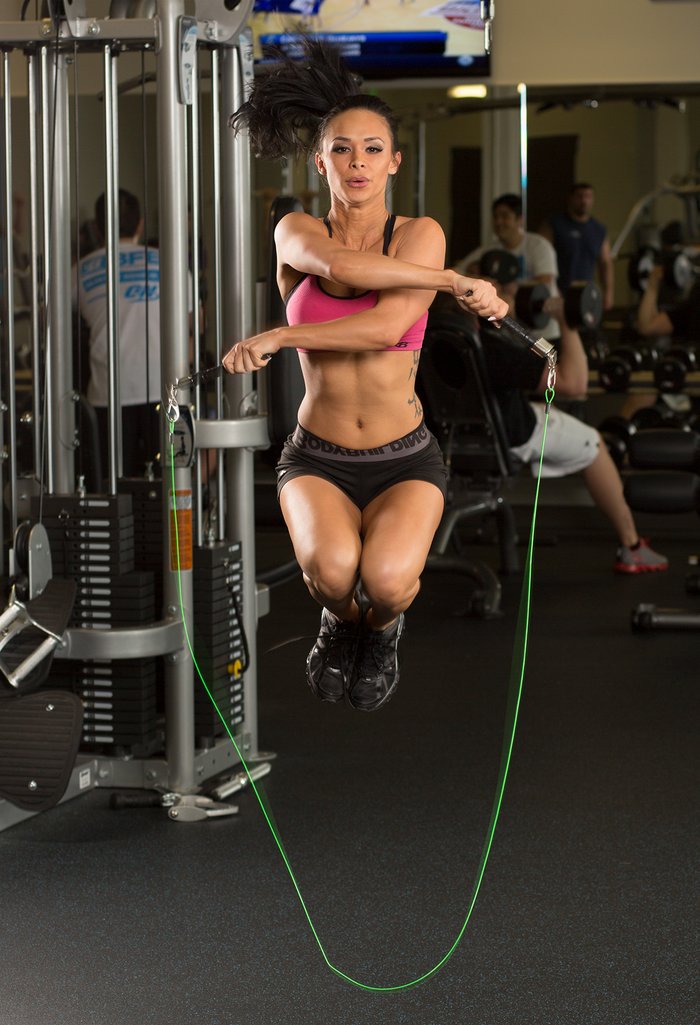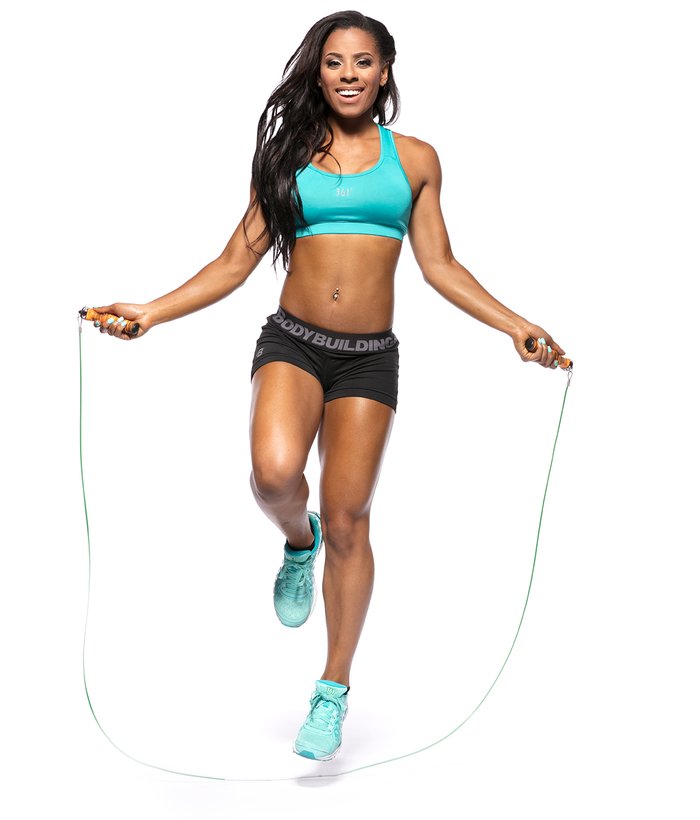"Jumping rope is a very good pre-workout exercise to increase core temperature and blood flow, and prepare your muscles for more work to come," says Tim Crowder, the owner and head athletic performance coach at Nuclear Athletes in Austin, Texas. "Most importantly, it's good for developing total-body coordination and connecting your mind with your body. This pays off when it comes time to mentally prepare for a workout."
Studies show that incorporating jump-rope training into your workout can improve motor control, cardiovascular capacity, and may even improve horizontal jumping ability.[1-3] And if you use a weighted jump rope? Well, you'll likely improve power and anaerobic capacity, too.[4]
The challenge, of course, is that jumping rope is tough. Aside from trying not to trip on the rope, you're also taxing your calves and shoulders with fast, repetitive movements. They can wear you down quickly if you're not used to them. Therefore, short bouts of jumping are your best bet, especially when first starting out, and a 10-minute routine is more than enough to put your body to the test.
So, go ahead—grab a rope and get started.
Choosing a Rope
As a diehard jump-rope fan, I can attest that not all ropes are created equal. You need a rope that's sized appropriately for your height: When you stand on the center of the jump rope, the handles should reach your armpits. It also should swing smoothly and easily. Avoid using a rope with any visible kinks, which can throw the turning motion off balance.

Personally, I'm a huge fan of interchangeable weighted ropes, which enable you to switch out the rope based on your workout goals. You can choose a lightweight rope to work on speed and cardio, or a heavier rope for developing power and upper-body endurance. There are a couple brands on the market, including Crossrope and SPRI, but any rope that feels comfortable and turns easily will work.
The Workout
This workout is split into three, three-minute rounds with 30 seconds of rest between each round. Try your best to keep the rope turning throughout, stopping only to switch exercises, as needed. Each round grows progressively more challenging, so do your best and switch to basic hops if you can't quite nail a specific exercise.
Round 1: Cardio

The goal for this round is to jump continuously, switching exercises every 30 seconds. Repeat the exercises two times through.
- Two-foot hops: This is your basic jump. Simply hop in place, jumping once for each turn of the rope.
- Heel taps: Jog in place, but instead of lifting your foot behind you with each step, reach your leg in front of you, tapping one heel on the ground.
- High knees: Jog in place, but bring your knee as high as you can in front of your body with each step.
After completing each of the exercises twice, rest for 30 seconds before continuing.
Round 2: Mind-Body Connection
As Crowder noted, jumping rope is a mental exercise as much as a physical one. These movements will force you to stay focused as you develop new skills and enhance coordination.
Perform each exercise for 30 seconds, pausing only long enough to switch movements. Repeat the series twice.
- Backward hops: The concept is identical to the basic jump, but instead of starting the rope behind you and spinning it forward over your head, start the rope in front of you and spin it backward over your head, so you're jumping over the rope as it passes under your feet from heel to toe.
- Cross legs: Start standing tall with your feet together. As you swing the rope on its first pass, jump your feet out laterally, as if you were doing jumping jacks. On the second pass, hop your feet inward, crossing your right foot over your left. On the third pass, hop your feet back out to the sides, and on the fourth pass, hop your feet inward, crossing your left foot over your right. Continue this pattern for the full 30 seconds.
- Torso twists: Start with your feet together. As you swing the rope on its first pass, jump up into the air and twist your hips and legs to the right while keeping your chest and shoulders forward-facing. On the next pass, twist your hips and legs to the left. Continue the left-right twist for the full 30 seconds.
After completing each of the exercises twice, rest for 30 seconds before continuing.
Round 3: Ultimate Intervals

Think of this round as a variation on a Tabata workout. You'll perform each exercise as fast and hard as you can for 20 seconds, followed by a 10 second rest. Do each exercise twice before moving on to the next exercise.
- Tuck jumps: Start with a basic two-foot hop, then with each turn of the rope, bring your knees as high as you can in front of your body, trying to explode up into the air.
- Crisscross arms: Start with a basic two-foot hop, then with each turn of the rope, drive your hands across your body, crossing your forearms before pulling your hands back to the starting position. Continue this crisscrossing action, switching which arm you cross over the other with each jump.
- Double-unders: Start with a basic two-foot hop, then spin the rope twice as fast, so the rope turns under your feet twice with each hop. This takes some practice! Aim to do just one, pause, then do another one, to get the exercise down before trying to string multiple double-unders together.
Sources
- Ozer, D., Duzgun, I., Baltaci, G., Karacan, S., & Colakoglu, F. (2011). The effects of rope or weighted rope jump training on strength, coordination and proprioception in adolescent female volleyball players. Journal of Sports Medicine and Physical Fitness, 51(2), 211.
- Partavi, S. (2013). Effects of 7 weeks of rope-jump training on cardiovascular endurance, speed, and agility in middle school student boys. Sport Sci, 6(2), 40-3.
- Makaruk, H. (2013). Acute effects of rope jumping warm-up on power and jumping ability in track and field athletes. Polish Journal of Sport and Tourism, 20(3), 200-204.
- Orhan, S. (2013). Effect of weighted rope jumping training performed by repetition method on the heart rate, anaerobic power, agility and reaction time of basketball players. Advances in Environmental Biology, 945-952.



